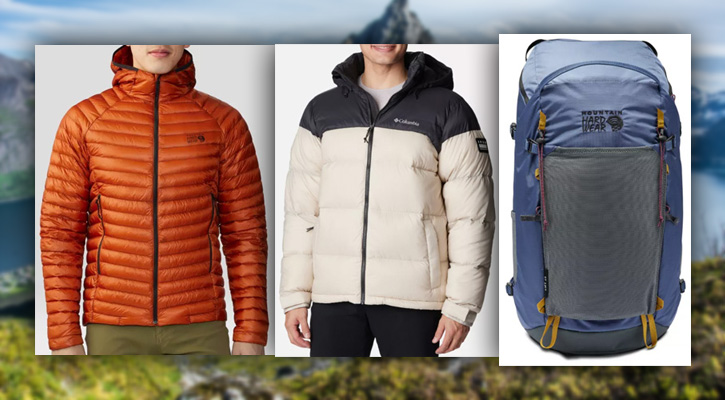
Both Mountain Hardwear and Columbia have been manufacturing clothing and equipment for decades, earning loyal followings among outdoor enthusiasts.
For activities like hiking, camping, skiing, and more, they consistently receive high marks!
But, while they share a focus on outdoor life, they have some differences in their product lines, designs, and market positioning.
In this article, we’ll compare them to help you determine which brand may be a better fit for your needs and intended activities.
We’ll examine their main products, materials, pricing, and more. Let’s begin!
Contents:
1. Mountain Hardwear Outdoor Gear
History of the Brand
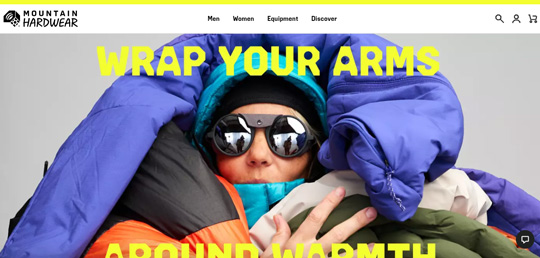
Mountain Hardwear’s official website
The Mountain Hardwear brand was founded in California, USA, in 1993, thanks to former employees of the Sierra Designs company.
Ed Viesturs, the first American athlete to summit fourteen 8000-meter peaks, significantly contributed to the brand’s early success through his sponsorship. This led to the brand’s ongoing association with alpine athletes and their achievements.
Years later, in 2003, Columbia Sportswear acquired the brand. However, it wasn’t until 2008 that the inaugural Mountain Hardwear retail store was established in Portland, Oregon, followed by another store in Seattle, marking a period of substantial expansion.
Don’t miss: 8 Brands like Mountain Hardwear: Our Best Alternatives
Materials, Fabrics, and Production Process
Mountain Hardwear has gained renown for its use of high-quality materials and innovative manufacturing methods, resulting in products that surpass expectations.
The brand’s mountaineering apparel offers exceptional performance for outdoor enthusiasts and athletes, boasting strong resistance and protection against low temperatures, along with superb thermal insulation. The company consistently enhances its production, refining designs to enhance athletes’ performance.
Their parkas, jackets, and other garments use high-fill-power down insulation, wool, and flannel fabrics, providing warmth even in the most frigid conditions. Additionally, some jackets use fleece, a soft material similar to sheep’s wool, offering warmth and comfort.
These materials are durable and resilient, maintain consistent body temperature, shield against the wind, and incorporate advanced technology.
Mountain Hardwear employs various fabric technologies such as Pertex Y Fuse, different options of Gore-Tex (Paclite, C-knit backer, Active, etc.), and Dyneema Composite fabrics.
PrimaLoft synthetic insulation and Polartec fleece are key components for warmth in many of their products, while some items also feature the RECCO® technology for advanced rescue capabilities.
Sustainability serves as a guiding principle for the company’s production processes and business practices, reflecting its commitment to environmental responsibility.
The video will be loaded from YouTube.com, a third party. If you play it, you accept their terms of service, and their use of cookies.
Read also: Mountain Hardwear vs The North Face: Which is Better?
Where is Mountain Hardwear outdoor gear made?
Mountain Hardwear’s items (together with other Columbia-owned labels) are mostly manufactured in Asia, specifically in countries like China, Bangladesh, India, and Vietnam. (source)
Recommended Products
Mountain Hardwear Men’s Ghost Whisperer/2 Hoody
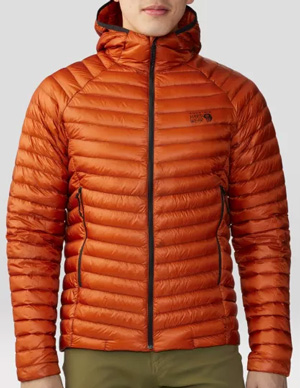
Image: mountainhardwear.com
Check it out at MountainHardwear.com
The Mountain Hardwear Men’s Ghost Whisperer/2 Hoody offers an ultralight and packable down jacket solution suitable for various outdoor pursuits. Made of 100% recycled nylon and featuring 800-fill-power RDS-certified down, it provides ethical warmth.
The jacket is designed for a standard fit to allow unrestricted movement and incorporates practical features such as synthetic insulation at the cuffs, an adjustable hood, and zippered hand pockets. It can be conveniently compressed into its pocket, facilitating travel.
Weighing approximately 8.8 ounces (249 g) for a medium size, the hoody strikes a balance between lightweight design and effective warmth, with a center-back length of 27.5 inches (69.9 cm). This sustainable option enables adventurers to reduce their environmental impact while enjoying comfort in outdoor settings.
Read also: Mountain Hardwear vs Patagonia (Outdoor Gear Comparison)
Mountain Hardwear Women’s JMT 25L Backpack
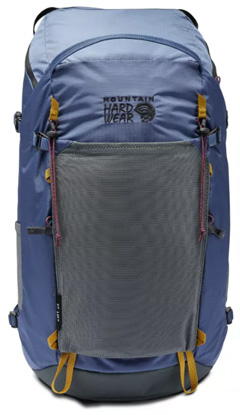
Image: mountainhardwear.com
Check it out at MountainHardwear.com
The Women’s JMT 25L Backpack by Mountain Hardwear is a robust and lightweight daypack crafted for outdoor pursuits like hiking and climbing. Constructed with a durable 500D CORDURA® base, it is engineered for longevity.
Tailored for women, the backpack boasts a ventilated mesh back panel and fully padded shoulder straps to ensure comfortable carrying. Its clamshell-style opening allows for easy access to gear, while the top zippered pocket aids in organization.
Side compression straps are included to secure the load, and attachment loops are provided for trekking poles or an ice axe. Offering a simple design and essential features, the JMT 25L is an ideal option for day hikers in search of both performance and comfort.
Prices
In general, Mountain Hardwear is placed in the mid-to-high price range. Their jackets range from $100 for simple styles to $1,000 for high-performance designs. The backpacks are priced between $90 for daypacks and $450 for advanced mountaineering packs.
Are Mountain Hardwear products worth the price?
We love the designs of this brand and after reading online feedback, it’s widely accepted that their gear is durable, long-lasting, practical, and very comfortable. So, with this pricing and such high quality, Mountain Hardwear is definitely worth it.
Must read: 9 High-End, Expensive Hiking Brands for Clothing and Footwear
2. Columbia Outdoor Gear
History of the Brand
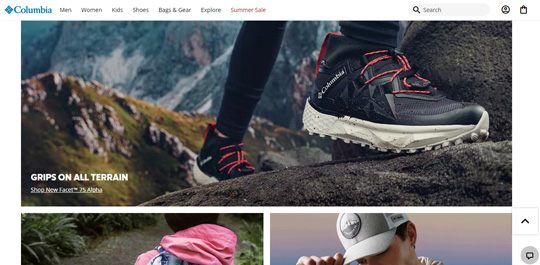
Columbia official website
Columbia is a well-established outdoor gear and clothing brand that provides a wide range of products suitable for various outdoor activities such as skiing, fishing, and hiking and also for casual everyday wear.
The company has a rich history, originally founded as the Columbia Hat Company in 1938 by the family of Gert Boyle, who fled Germany and settled in Portland, USA.
Over the years, the business transitioned through different family members and evolved into the Columbia Sportswear Company in 1960, focusing on outdoor apparel. Presently, the company is under the leadership of Tim Boyle, Gert’s son.
Don’t miss: 10 Brands like Columbia Sportswear: Our Top Alternatives
Materials, Fabrics, and Production Process
Columbia Sportswear employs its proprietary fabric and insulation technologies to maximize the functionality of its outdoor products.
An example is the Omni-Tech fabric technology which enhances the waterproof and breathable qualities of Columbia’s jackets. Another innovation is the Omni-Heat Reflective technology, which enables their apparel to effectively retain warmth while releasing excess moisture and heat.
Next, recycled Polyester and RDS-certified natural down insulation, along with a dedication to minimizing the use of harmful DWR coatings, further reinforce their commitment to sustainable materials.
The manufacture of Columbia Sportswear products adheres to the high standards established by Gert Boyle, resulting in top-quality apparel. The brand offers a large range of reliable outdoor gear at affordable prices, presenting a great quality-to-price ratio in the market.
The video will be loaded from YouTube.com, a third party. If you play it, you accept their terms of service, and their use of cookies.
Read also: Marmot vs Columbia: Which is Better for Outdoor Gear?
Where is Columbia outdoor gear made?
Columbia continues to manufacture outdoor equipment in the United States and Europe, but the majority of its products, including its subsidiary brands such as Sorel, prAna, and Mountain Hardwear, are produced in Vietnam, China, Bangladesh, and India. (source)
Recommended Products
Columbia Men’s Bulo Point II Down Jacket
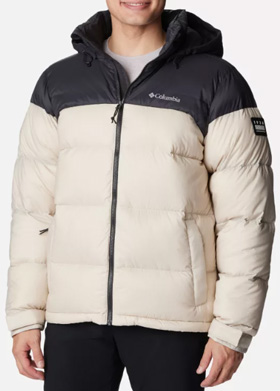
Image: columbia.com
Check it out at Columbia.com
The men’s Bulo Point II Down Jacket from Columbia is an insulated and water-resistant outerwear option suitable for cold conditions. It incorporates 700-fill-power goose down for warmth and includes Columbia’s Omni-Heat™ Infinity thermal-reflective lining to preserve body heat.
The jacket is crafted with a detachable, adaptable hood, chin guard, and adjustable cuffs and hem to deliver a secure fit and added warmth. It has an interior security pocket and zippered hand pockets for essential items.
This lightweight jacket can be packed into its stuff sack, making it convenient for travelers or those who need to reduce space. Featuring a 28-inch center back length, it provides extensive coverage while ensuring durability.
Read also: How To Wash a Columbia Jacket (Omni-Heat, Down, Fleece, Rain)
Columbia Atlas Explorer 26L Backpack
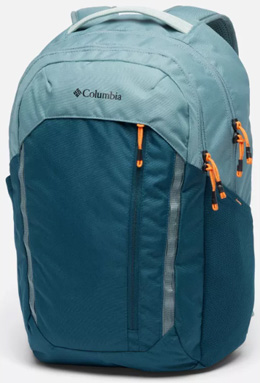
Image: columbia.com
Check it out at Columbia.com
The Atlas Explorer is a versatile and comfortable backpack suitable for a variety of uses. With a 26-liter capacity, it includes a front pocket organizer, two primary storage sections, individual compartments for a laptop and a tablet, adjustable sternum and shoulder straps, and dual water bottle pockets.
The backpack has Twin Slot webbing for adaptability and accommodates laptops up to 15 inches. It’s also designed with two water bottle pockets, reflective zipper pulls, and a padded bottom panel.
Don’t miss: Eddie Bauer vs Columbia: Which Brand is Better?
Prices
Compared to Mountain Hardwear, Columbia is priced more affordably. In general, Columbia’s jackets can cost from $50 to $300, their backpacks under $100, and their hiking shoes begin at about $100.
Are Columbia products worth the price?
For casual and general outdoor pursuits, we believe the company’s items are great. For example, their coats offer the essential warmth and protection you need in winter.
If you are an outdoor expert or at a higher skill level, you may want to look for a brand with more technical features. But, even then, you can find a suitable item from Columbia’s large collection to complete your gear list.
Must read: Cheap Outdoor Clothing: 9 Best Affordable Brands
3. Which is Better? Mountain Hardwear or Columbia?
Even if these two names are both part of the same company, Columbia Sportswear, there are a few differences in their types of products and market positioning.
So, which one should you choose? Here are our considerations to keep in mind during your purchase:
- Mountain Hardwear focuses more on technical mountain and alpine gear like jackets, pants, base layers, packs, and so on. Their clothing is designed for more extreme and rugged outdoor activities in colder and wetter conditions. Quality and features are generally very high.
- Columbia is more versatile and lifestyle-focused. While they do offer technical outdoor gear, they also have a lot of casual and urban styles suitable for things like hiking, biking, and travel. Performance is usually not as advanced as Mountain Hardwear for serious mountaineering.
- Mountain Hardwear gear is more expensive on average. You’re paying more for premium alpine and mountaineering materials and construction.
- Columbia has a much broader product range beyond just outdoor gear. They offer sportswear, shoes, and more.
In the end, Mountain Hardwear is better, in our opinion, if you need the best technical gear for serious alpine and winter mountaineering, skiing, expeditions, or ice climbing.
Columbia is a good all-around choice for general outdoor activities from casual hiking to travel to more rigorous pursuits. Performance is very good for the price you pay.
So, it depends on your needs. For example, Mountain Hardwear may be too much for mild-weather hiking.
Read also: 8 Best Sustainable Outdoor Clothing Brands: Our Top Picks
